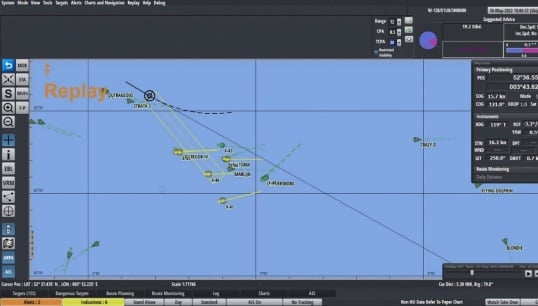- Topics
- Campaigning
- Careers
- Colleges
- Community
- Education and training
- Environment
- Equality
- Federation
- General secretary message
- Government
- Health and safety
- History
- Industrial
- International
- Law
- Members at work
- Nautilus news
- Nautilus partnerships
- Netherlands
- Open days
- Opinion
- Organising
- Podcasts from Nautilus
- Sponsored content
- Switzerland
- Technology
- Ukraine
- United Kingdom
- Welfare

Debbie Hull, managing director of ECDIS Ltd, welcomes Nautilus members to the 6th generation of ECDIS
On 16 September 1620, the Mayflower sailed to the new world using astronomy. On 16 September 2024, the 6th Generation of ECDIS sailed with AI.
The first generation of ECDIS, launched in 1979, caused a huge shake-up. Even the most cynical have since embraced the technology. Today, charts are uploaded and updated, and real-time situational awareness, continuous positional information and shipping information are all overlaid on the navigational track. The system improves safety and allows more time for looking out of the window.
'6th Generation' is another step change, allowing the ECDIS to automatically create routes, define safe water, and manoeuvre within the COLREGs. Dynamic squat and automatic UKC tools have been added, with new routeing charts integrated to make AI generated route calculations more fuel efficient.
But is this generation of software safe, and should it be trusted?
Appraisal
On certain systems ECDIS can define safe water by automatically interpolating between charted depths to make quick and alarmable 'no-go' areas.
It is quick to use (an entire port can be completed within a few minutes) and does not miss a sounding, but it is not entirely clear how the software interpolates between the soundings and does not apply to charted objects such as buoys or anchorage areas. There are also issues when an area has few soundings due to older survey data. Having said this, there is no doubt that it is safer and more accurate than relying on the Safety Contour.
Planning
6th Generation software includes quick, automatic optimal route creation for fuel efficiency, and known recognised routeing. However, on occasion the automatic route can create unrealistic turns or pass over a navigation aid. The planned speed is usually standard, and the plan does not account for shipping traffic, the environment, or the weather. These issues can be overcome by manipulating the automatic route.
At ECDIS Ltd a route was created on paper, on ECDIS, and by automatic ECDIS route creation software. The closest match was between the paper route and the automatic software – showing automatic route creation is aligned with traditional navigational methods.
Execution and monitoring
Using track control systems, a ship will follow a pre-planned track under various conditions. Some recent systems can calculate and correct drift. The ECDIS operator is alerted to navigational warnings and potential dangers.
A 'look-ahead' function is available on all ECDIS units, but some have new dynamic features. Certain manufacturers use a tidal vector which can automatically alter the wheel to account for set and drift.
A path predictor function, if available, allows the user to predict the heading of the ship when turning in particularly confined waters, though this doesn't replace visual verification.
The future
As 6th Generation software becomes more normal onboard, the 'periodically unattended bridge' appears to be within reach. The latest ECDIS system plans and follows a route automatically and adapts to scenarios while applying COLREGs and remaining within the limits of safe water. In 2024, the first manufacturer received DNV approval for integrating these functions into the ECDIS software.
Training providers of the Type Specific ECDIS courses work hard to keep up with these technological advances. eMaritimeTraining.com reported they are 85% through the process of updating their online courses. Seafarers are naturally cautious when it comes to new technology, but those that have used the new features can't remember a world without them. They use this software every day, apply sensible amounts of caution, and are looking forward to the future.
Tags
